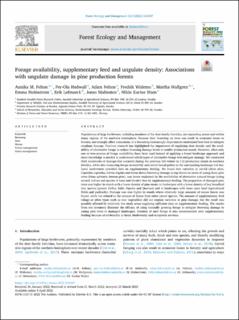| dc.contributor.author | Felton, Annika M. | |
| dc.contributor.author | Hedwall, Per-Ola | |
| dc.contributor.author | Felton, Adam | |
| dc.contributor.author | Widemo, Fredrik | |
| dc.contributor.author | Wallgren, Märtha | |
| dc.contributor.author | Holmström, Emma | |
| dc.contributor.author | Löfmarck, Erik | |
| dc.contributor.author | Malmsten, Jonas | |
| dc.contributor.author | Wam, Hilde Karine | |
| dc.date.accessioned | 2022-07-15T08:21:09Z | |
| dc.date.available | 2022-07-15T08:21:09Z | |
| dc.date.created | 2022-05-10T12:22:41Z | |
| dc.date.issued | 2022-04-05 | |
| dc.identifier.citation | Forest Ecology and Management. 2022, 513 . | en_US |
| dc.identifier.issn | 0378-1127 | |
| dc.identifier.uri | https://hdl.handle.net/11250/3005678 | |
| dc.description.abstract | Populations of large herbivores, including members of the deer family Cervidae, are expanding across and within many regions of the northern hemisphere. Because their browsing on trees can result in economic losses to forestry and strongly affect ecosystems, it is becoming increasingly important to understand how best to mitigate resultant damage. Previous research has highlighted the importance of regulating deer density and the availability of alternative forage to reduce browsing damage levels in conifer production stands. However, often only one or two proxies of forage availability have been used instead of applying a broad foodscape approach and more knowledge is needed to understand which types of alternative forage best mitigate damage. We conducted field inventories of damage that occurred during the previous fall/winter in 112 production stands in southern Sweden, while also measuring forage availability and cervid faecal pellets in the surrounding landscape (16 ha). Local landowners provided data on supplementary feeding. We found that variation in cervid (Alces alces, Capreolus capreolus, Cervus elaphus and Dama dama) browsing damage to top shoots or stems of young Scots pine trees (Pinus sylvestris, hereon pine), was better explained by the availability of alternative natural forage (using several indices and species of trees and shrubs) than by supplementary feeding. The proportion of damaged pine trees was higher in stands with a lower density of pine stems; in landscapes with a lower density of key broadleaf tree species (genera Sorbus, Salix, Populus and Quercus); and in landscapes with more open land (agricultural fields and paddocks). Damage was also higher in stands where relatively large amounts of moose faeces was found, while not related to the amount of faeces from other cervid species. The amount of supplementary feed (silage or other types such as root vegetables) did not explain variation in pine damage, but the result was possibly affected by relatively few study areas supplying sufficient data on supplementary feeding. The results from our inventory illustrate the efficacy of using naturally growing forage to mitigate browsing damage to young pine trees in managed landscapes. Creation of such forage is also recommended over supplementary feeding because of co-benefits to forest biodiversity and ecosystem services. | en_US |
| dc.language.iso | eng | en_US |
| dc.publisher | Elsevier B.V. | en_US |
| dc.rights | Navngivelse 4.0 Internasjonal | * |
| dc.rights.uri | http://creativecommons.org/licenses/by/4.0/deed.no | * |
| dc.title | Forage availability, supplementary feed and ungulate density: Associations with ungulate damage in pine production forests | en_US |
| dc.title.alternative | Forage availability, supplementary feed and ungulate density: Associations with ungulate damage in pine production forests | en_US |
| dc.type | Peer reviewed | en_US |
| dc.type | Journal article | en_US |
| dc.description.version | publishedVersion | en_US |
| dc.rights.holder | © 2022 The Authors | en_US |
| dc.source.pagenumber | 11 | en_US |
| dc.source.volume | 513 | en_US |
| dc.source.journal | Forest Ecology and Management | en_US |
| dc.identifier.doi | 10.1016/j.foreco.2022.120187 | |
| dc.identifier.cristin | 2023050 | |
| dc.source.articlenumber | 120187 | en_US |
| cristin.ispublished | true | |
| cristin.fulltext | original | |
| cristin.qualitycode | 2 | |

